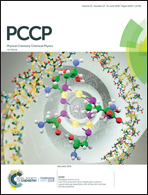Interface-tuned selective reductive coupling of nitroarenes to aromatic azo and azoxy: a first-principles-based microkinetics study†
Abstract
It is of great importance to regulate a catalyst to control its selectivity. In general, the Pt catalyzed hydrogenation of nitrobenzene (PhNO2) would produce aniline. Yet, when KOH is added, the more value-added N–N coupling products such as aromatic azoxy and azo exhibit better selectivity. To identify the key factors governing the selectivity towards aromatic azoxy and azo in a complex reaction network, the reaction mechanisms of PhNO2 hydrogenation over Pt(111) are systematically investigated on the Pt(111) surface and at the KOH/Pt(111) interface utilizing microkinetic simulations based on the PBE-D3 calculated results. It is found that the selectivity strongly depends on the adsorption configuration of PhNO2 rather than on the coverage of the surface H*. In neutral environments, PhNO2 tends to lie flat on the Pt(111) with chemisorption of the phenyl group, which is in favor of the production of aniline. The addition of KOH makes PhNO2 preferentially chemisorb at the KOH/Pt(111) interface via the nitro group without the chemisorption of the phenyl group, which is in favor of the N–N coupling products. The KOH-induced tilted adsorption configuration and extra stabilization could promote the dehydroxylation of PhNOH* to form PhN*, which is the key intermediate for the production of azoxy and azo.



 Please wait while we load your content...
Please wait while we load your content...